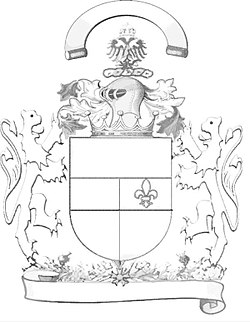Helmet gem
A helmet jewel (also Helmzier , Cimir , Zimier or Clainot ) is an attached decorative attachment for helmets that was worn by knights .
Function and presentation

Ornaments and jewels have been documented since the early 13th century and probably originally served to better identify knights in the fray. Originally, the crest repeated the shield coat of arms (they were tinged in the same way ), but then additional attributes were added that supplemented this or indicated the rank.
In heraldry , they are used in particular to distinguish coats of arms with the same shield, in later heraldry they also serve to distinguish individual members, branches or residences of a family: the crest is also based on personal characteristics.
In the second half of the 14th century the cimery became more imaginative and was often fictitious. They should be cut off in combat at the tournament . These helmet ornaments were made from wood and wire frames, paper mache and natural materials such as fabrics and animal parts. They were mounted on top of the helmet or pulled over it like a hat, so they could sit heraldically on the helmet cover and the helmet crown or grow out of the cover.
Mostly they were figurative representations of people, plants, animals, wings, horns or objects. These pictorial elements are collectively referred to by the heraldic technical term common figure . Together with a helmet and shield , they form the coat of arms . It was only through the crest that a helmet became heraldic or heraldic. Crest and helmet are assigned to the upper coat of arms . Depending on the crest, the heraldic helmet is normally facing the viewer or looking forward ( heraldic right , i.e. left in the picture).
In post- medieval heraldry, in the case of a coat of arms association , the helmets are gathered on the united shield in the full coat of arms. If there are several helmets over a coat of arms, the helmet decorations should be aligned according to the direction of the helmets. If there are two ornaments, they are turned towards each other or turned away. If three helmets are decorated, the middle one is turned towards the viewer independently of the others.
- Crest ornaments and jewels
Albert von Pranckhs Kübelhelm , 14th century ( Kunsthistorisches Museum in Vienna, Austria)
Pot helmet with crown (replica)
Crest in the form of a hydra (Northern Italy, 15th century)
Examples

Common crests are:
- Flight , open or closed, as a bearer of the coat of arms
- Cushions , open or closed, as a carrier of the coat of arms or a base for the actual helmet ornament
- Screen board as a projection surface for the contents of the sign
- Feather frame ( quiver and basket ), with ostrich and peacock feathers
- various headgear, such as crown , hat , inful (bishop's cap ), pouch stand , the latter also as a projection surface for the contents of the shield
- Flags
- Buffalo horns , tinged or draped
- Clothing of characters of the shield image
- People or heraldic animals , as a figure, doll ( commonly used as an expression for the torso of growing figures), also heads
- Labels that repeat the image of the shield
Badge of the Prince of Wales with three ostrich feathers in a simple crown and the motto "I SERVE" for the Prince of Wales
Thuringian or helmet groschen (1405–1411) from the Freiberg mint with the Thuringian helmet jewel
See also
- Crista of the Roman cassis and other helmets
- Feather headdress
- Crest
- Lophos (horse's mane ) on the Greek helmet
- Maedate , Japanese equivalent
literature
- Friedrich-Karl zu Hohenlohe-Waldenburg: About the use of heraldic helmet ornaments in the Middle Ages. Cultural-historical sketch . Weise, Stuttgart 1868. (digitized version)
- Hans and Maria Rüegg: The crest . Lecture from April 2, 2004 at the 777th Bott of the Zurich Heraldry Guild. ( online ).
Web links
- Introduction to heraldry: helmet ornament by Bernhard Peter
- Helmet with Zimier and shield Edward, the Black Prince on his tomb in Canterbury Cathedral, Project Gutenberg , helmet with Zimier of Sir John Gostwick in Willington Church, Bedfordshire, Project Gutenberg , helmet of Sir George Brooke in Cobham Church, Kent, Projrkt Gutenberg Photos of three English helmets with original zimier . These helmets served as funeral helmets .










